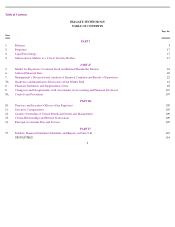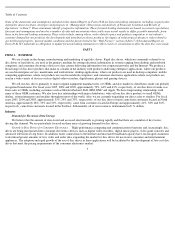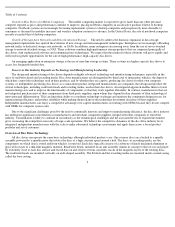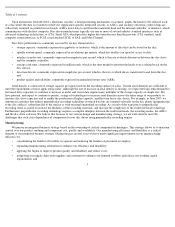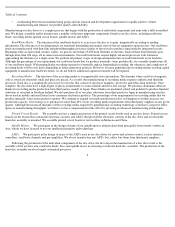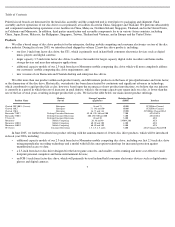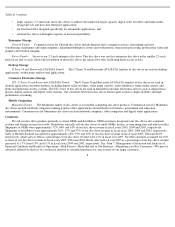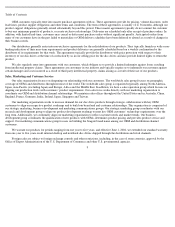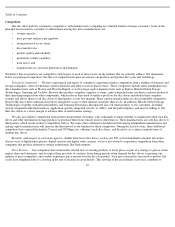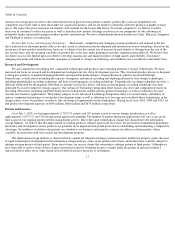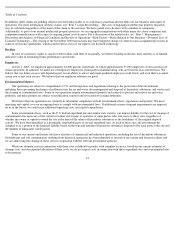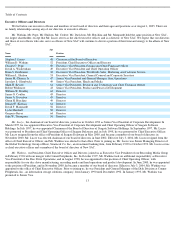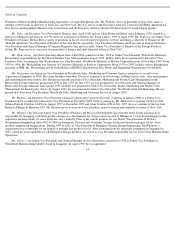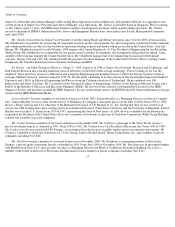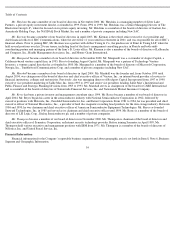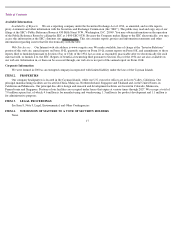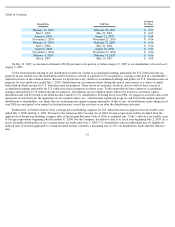Seagate 2004 Annual Report Download - page 13
Download and view the complete annual report
Please find page 13 of the 2004 Seagate annual report below. You can navigate through the pages in the report by either clicking on the pages listed below, or by using the keyword search tool below to find specific information within the annual report.
Table of Contents
increases in average price erosion to the extent that historical price erosion patterns continue, product life cycles are lengthened, our
competitors have more time to enter the market for a particular product, and we are unable to offset this with new products at higher average
prices. We expect that price erosion in our industry will continue for the foreseeable future. To remain competitive, we believe it will be
necessary to continue to reduce our prices as well as introduce new product offerings in advance of our competitors to take advantage of
potentially higher initial profit margins on these product introductions. We have established production facilities in China, Malaysia, Singapore
and Thailand to achieve cost reductions.
Product Life Cycles and Changing Technology . Historically, competition and changing customer preference and demand in the disc
drive industry have shortened product life cycles and caused acceleration in the development and introduction of new technology. Based on the
recent pace of new product introductions, however, we believe that the current rate of increase in areal density is slowing from the rate of the
last several years, and the resulting variability in product life cycles may make planning for product transitions more difficult. We believe that
our future success will depend upon our ability to develop, manufacture and market products of high quality and reliability which meet
changing user needs and which successfully anticipate or respond to changes in technology and standards on a cost-effective and timely basis.
Research and Development
We are committed to developing new component technologies and products and evaluating alternative storage technologies. We have
increased our focus on research and development and realigned our disc drive development process. This structured product process is designed
to bring new products to market through predictable and repeatable methodologies. Seagate Research, which is based in Pittsburgh,
Pennsylvania, is dedicated to extending the capacity of magnetic and optical recording and exploring alternative data storage technologies,
including perpendicular recording technology and heat assisted magnetic recording technology. Perpendicular recording technology involves a
different orientation for the magnetic field than is currently used in disc drives, and heat assisted magnetic recording technology uses heat
generated by a laser to improve storage capacity. Our Advanced Technology Integration effort focuses disc drive and component research on
recording subsystems, including read/write heads and recording media, market-specific product technology as well as technology focused
towards new business opportunities. The primary purpose of our Advanced Technology Integration effort is to ensure timely availability of
mature component technologies to our product development teams as well as allowing us to leverage and coordinate those technologies in the
design centers across our products in order to take advantage of opportunities in the marketplace. During fiscal years 2005, 2004 and 2003, we
had product development expenses of $645 million, $666 million and $670 million, respectively.
Patents and Licenses
As of July 1, 2005, we had approximately 2,710 U.S. patents and 501 patents issued in various foreign jurisdictions as well as
approximately 1,027 U.S. and 766 foreign patent applications pending. The number of patents and patent applications will vary at any given
time as part of our ongoing patent portfolio management activity. Due to the rapid technological change that characterizes the information
storage industry, we believe that the improvement of existing products, reliance upon trade secret law, the protection of unpatented proprietary
know-
how and development of new products are generally more important than patent protection in establishing and maintaining a competitive
advantage. Nevertheless, we believe that patents are valuable to our business and intend to continue our efforts to obtain patents, where
available, in connection with our research and development program.
The information storage industry is characterized by significant litigation relating to patent and other intellectual property rights. Because
of rapid technological development in the information storage industry, some of our products have been, and in the future could be, alleged to
infringe existing patents of third parties. From time to time, we receive claims that our products infringe patents of third parties. Although we
have been able to resolve some of those claims or potential claims by obtaining licenses or rights under the patents in question without a
material adverse affect on us, other claims have resulted in adverse decisions or settlements.
11



